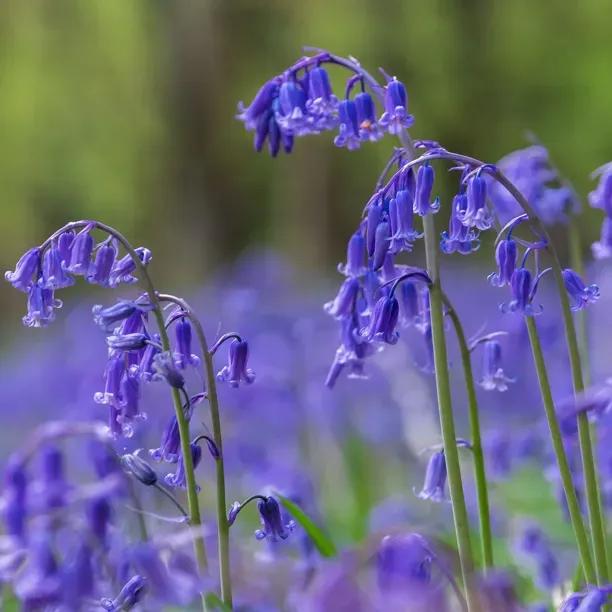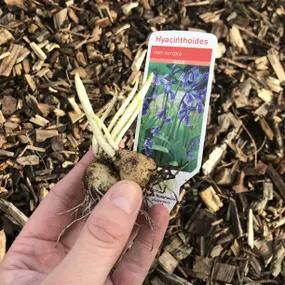British Bluebell Bulbs in the Green
Honest Delivery PricesHyacynthoides non scripta
- In the green: lifted & planted in spring.
- Native
- Colour: Violet-blue
- Height: 30-40cm
- Scent: Honey
- Flowering: April-May
- Bulb Size: Premium
- Planting Depth: 12-20 cm
- Great for bees, thrives in dappled shade.
Recommended extras
Description
Hyacynthoides non scripta: Bulbs in the Green
Bluebells in the green are grown in the UK and sold for planting in the spring. These are the true native English bluebell. In the green (which is a bit of a misnomer) simply means that the bulbs are in full growth and are delivered either while still in growth or when their foliage has freshly died back - so it can be yellow and shrivelled later in the season. This ensures the bulbs are moist which helps them establish more rapidly when they come into growth again.
Please note: Bluebells "in the green" is a misnomer, as the foliage can be yellow and shrivelled: this is normal, and has no adverse effect.
Browse our range of bulbs in the green.
There are a few bulbs and tubers that transplant at least as well and sometimes better when they are moved during their growing as opposed to their dormant season. These include snowdrops and aconites as well as bluebells. The science behind this revolves around the way that nutrients that are present in leaves and flower sink back into the bulb as the plant dies down in early summer and are then reused by it to kickstart growth in the following season.
Bluebells are amongst the best-known spring flowering plants. They grow wonderfully well in the UK where their early flowering is helped mightily by the warmth of the Gulf Stream.
Features
- Colour: Blue
- Sweet scent
- Height: 30+cm
- Flowering: Apr-May
- Sold in the green for immediate planting.
Growing Bluebells
They perform best when grown in moist ground containing plenty of organic matter. Plant them at between 40 and 50 bulbs per square metre.
Like many early flowering bulbs that are dormant in summer, they are happier growing in locations that are shaded when trees are in leaf as they prefer moist soil which tends to be easier to find in cooler spots. So try to select a planting site that emulates these conditions. The ground should be weed free, dug over well to allow for easy root growth, and it is best when improved with well-rotted organic matter to help retain moisture.
Buying bulbs in the green means you receive growing plants that are freshly lifted. A few species of bulb, including bluebells and snowdrops, establish best when they are transplanted quickly either while still in growth or when their foliage has freshly died back. This ensures the bulbs are moist which helps them establish more rapidly when they next come into growth; "in the green" is a misnomer, as the foliage can be yellow and shrivelled: this is normal, and has no adverse effect.
They really do need to be planted as quickly as possible after being lifted as their foliage is perishable and deteriorates rapidly after a few days. We, therefore, restrict our shipping dates from February until May to weeks when the weather means your bluebells can be lifted immediately before despatch and are posted to arrive with you on a Thursday or Friday in time for planting that weekend.
When they are established, they spread quite vigorously, and will take over flower beds if you let them.
Planting Companions for Bluebells
The classic woodland for bluebells is mostly birch, where the amount of dappled shade is perfect for them. They also like being in the shade of a country hedge.
Planting Instructions
Bluebells prefer neutral to chalky soils but will grow well in acidic soil as well as long as it contains plenty of well rotted organic matter. Bluebell bulbs multiply rapidly and so can make quite large clumps. To achieve a natural look, we suggest you plant them in irregular shaped drifts of about 30 bulbs.
Planting depth should be about 5" (12 cms) and we would suggest leaving the same distance between your bluebells so as to give them a little room in which to spread. Water well after planting bulbs in the green as it is important to ensure there is good contact between soil and root and that there are no large air pockets.
For best flowering, lift and divide congested clumps when you see them in February or March.
Did You Know?
Our bulbs are field grown and never taken from wild populations of bluebells in woodland.
Bluebells enjoy some of the more interesting local names; Bluebottle, Calver keys, Cover keys, Crake feet, Crow bells, Crow leek, Cuckoo flower, Culver keys, Dog leek, Fairy flower, Harebell, Single gussies, Squill, Wood bells
The easiest way to tell the difference between native and non-native bluebells is to look at the colour of the pollen. If it is creamy-white then the bluebell is a native. If it is any other colour, such as pale green or blue, then it is probably not native.



